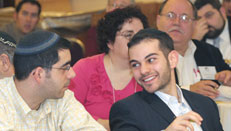 |
||||||||||||
| Weekly Parsha | ||
| Current Week | ||
| Parsha Archives | ||
| Business Ethics | ||
| Dr. Malamet Speaks Out | ||
| TiM MP3 Library | ||




A Thought for the Week with Rabbi Jay Kelman
|
 "Keep the harvest festival as the year changes" ( Shemot 34:22). This (half) verse is the only reference to Sukkoth (or more precisely Chag Ha'aseif , the harvest festival) in the Torah reading that our Sages have ordained for Shabbat Chol Hamoed . This reference seems like a rather weak reason for the choosing of this reading for Shabbat Chol Hamoed . Actually, the Torah reading chosen for Sukkoth seems much more appropriate for Yom Kippur. Its main focus is the aftermath of the chet haegel , the sin of the golden calf, for which forgiveness was granted on that first Yom Kippur; thereby serving as the basis for its observance today. The 13 attributes of G-d's mercy, a central focus of our Yom Kippur prayers as we beseech G-d for forgiveness, are revealed here in conjunction with the granting of forgiveness for the chet haegel . Yet this Torah section is ignored on Yom Kippur. Apparently, our Sages did not want any mention of the golden calf on Yom Kippur, focusing instead on the elaborate Temple service in the morning, and the importance of sexual morality during the afternoon Torah reading. So deep is the aversion to any mention of the sin of the golden calf that the high priest was forbidden to wear his golden vestments during his special Yom Kippur service, lest the gold itself be a reminder to this terrible sin and atonement denied. Yet if our Sages chose this particular reading for Shabbat chol hamoed , apparently the sin of the golden calf must be part and parcel of the holiday of Sukkoth. The Torah reveals this tragic story, and then commands us (seemingly out of left field) to observe the three pilgrim festivals of Pesach, Shavuot, and Sukkoth, followed by a number of laws relating to these festivals. Not only is the connection hard to fathom, but the pilgrim festivals and these same laws are recorded in the Torah almost verbatim just a few chapters earlier (see Shemot 23:15-19), making their mention here quite superfluous. The appearance of Pesach, Shavuot, and Sukkoth at this point in the Torah must therefore be seen as a response to chet haegel . The sin of the golden calf has its roots in the inability to see G-d's role in our day-to-day life. The generation that left Egypt was unable to maintain a constant belief in G-d; they needed miracle after miracle to feel His presence. When G-d's presence was not easily discernable, they resorted to building a golden calf. Pesach, Shavuot, and Sukkoth demonstrate G-d's ongoing role in history, marking the key aspects of Jewish nationhood. They are meant to strengthen our faith in G-d, even when our historical mission seems to have taken a detour. Sukkoth was meant primarily as an agricultural festival, something that is celebrated in all societies to give thanks for the harvest. While the holiday of Sukkoth is mentioned seven times in the Chumash, the obligation to dwell in Sukkah huts only comes up once; the other six references are to the agricultural aspect of the festival. The holiday is primarily, at least in the Biblical text, Chag ha'aseif , not Chag haSukkot . The Torah, however, wanted us to sanctify what could easily be viewed as a secular festival of thanksgiving into a chag l'Hashem , an agricultural festival acknowledging that only through Divine blessing will our hard work meet with success (for development of this theme, see Rabbi Mordechai Breuer, Pirkei Moadot ). This concept of sanctifying the physical and mundane aspects of life is a major Biblical theme. The Netziv (24:22) makes an astounding, if tentative, claim based on this line of reasoning; that had the Jewish people not made the golden calf, the holidays of Shavuot and Sukkoth would not have been observed during a shmitta year. Shavuot and Sukkoth are referred to as Chag Hakatzir and Chag Ha'aseif , the beginning of the harvest and the gathering of the harvest. With the fields lying fallow during the sabbatical year, there would be no need to celebrate these agricultural holidays. However, with the sin of the golden calf, the Netziv argues, the nature of Sukkoth changed to one in which fear of and faith in G-d are the central themes of the holiday. No longer is Sukkoth primarily the harvest festival. Now it is a festival designed to impress upon us G-d's continuing role in history. Shmitta or no shmitta , harvest or no harvest, our sin with the golden calf demonstrated the need for Sukkoth, so that "future generations will know that I had the Israelites live in huts when I brought them out of Egypt . I am the Lord your G-d". May we merit seeing the Almighty's guiding hand in all that we do. |
|
|

 |
 |